![]()
Do bi-coloured, green and blue beryls exist, which are composed of emerald and aquamarine zones?
George Bosshart
Horgen–Zurich, Switzerland
Introduction by Pala International
We are pleased to publish the following, an elaboration of a poster session presented by the late George Bosshart to the 32nd International Gemmological Conference, July 14, 2011, in Interlaken, Switzerland. For some background on this paper, see the February 2012 newsletter article from our sibling website.
Numerous colour-zoned minerals occur in nature, such as strikingly multi-coloured tourmalines from Madagascar (Fig. 1: red / dark green / yellow / purple-pink), spodumenes with pyramidal colour zoning from Afghanistan (Fig. 2: purple / light green), emeralds with sharply defined basal zoning, e.g. from Torrington, New England, Australia (Fig. 3: Cr-green / colourless / Cr-green) and from Colombia (Cr-green / yellow-green / Cr-green).
 |
| Figure 1. Purple-red tourmaline from Madagascar, exhibiting an astounding repetition of sharp basal colour zones. Weight 9.75 ct. Octagonal step cut. Length 27.05 mm. (Photo by the author) |
 |
| Figure 2. Phantom-like purple kunzite crystal from Afghanistan, terminated by a pyramidal zone of light green colour. Weight 138.25 ct, width of green zone 2-3 mm. (Photograph by the author) |
 |
| Figure 3. Emerald crystal from Torrington (NSW) showing sharp, basal, colourless and green colour zones, in a typical sequence of bands of variable thickness. Weight 7.08 ct, length 17.50 mm. (Photo by the author) |
Viewing a blue and green beryl crystal from Binn Valley, Switzerland (Fig. 4), the question came up: Do bi-coloured, emerald-aquamarine beryls also exist? Going by the feedback from numerous leading mineral and gem dealers in Europe, the United States, and Brazil and by the outcome of extensive literature searches (e.g. Sinkankas, 1981), the answer was: No. But a few beryl occurrences world-wide might prove them wrong.
 |
| Figure 4. Marvel of a blue-and-green beryl crystal from the Binn Valley, Valais, Switzerland. Total length approximately 8 mm. Emerald and Aquamarine? (Photo: M. Krzemnicki) |
The Binn Valley (Binntal) in the southwestern Swiss Alps is one of the best known mineral eldorados in the Alps thanks to an overwhelmingly rich variety of mineral species (Parker, 1973; Stalder et al., 1978). Typically most of these minerals are of small size and come in limited quantities but many are extremely rare and a number of them even endemic, especially some of the sulfosalts. The find of emerald crystals in the Feldbach valley, Binntal, by Swiss rockhounds T. Mumenthaler and A. Frey in the early 1980s, kept secret for two decades, came as a surprise when published in 2003 (in French and German). The occurrence is located at the contact of a steeply dipping mica schist band and a white dolomite lens. It is exposed to harsh climatic conditions so that emerald crystals mostly were found in the weathered debris wash. In 18 short summer campaigns, approximately 250 emerald specimens (Fig. 5) were recovered by a double-straining extraction method, applying two stacked sieves of unequal mesh size.
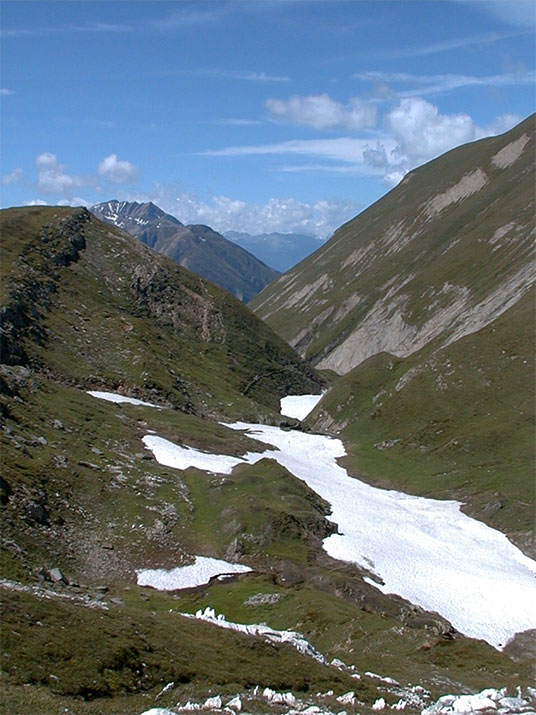 |
| Feldbach, Binn Valley. (Photo: A. Frey) |
The emeralds themselves were not remarkable for their size (mm to cm) but for their transparency and especially for the quality of their colour, duplicating that of Colombian emeralds, as a result of similar chemical compositions, with the V3+ chromophore dominating over Cr3+ (Krzemnicki & Bosshart, 2003). Freely grown single crystals were intact and transparent hexagonal prisms (Fig. 5). However, elongated beryl prisms in full contact with the quartz matrix were multiply broken in basal directions (by regional tectonic activity) and encrusted with rusty-brown ferrous hydroxide. This causes their impure brown-green appearance. Mumenthaler and Frey also observed a few specimens of emerald crystals on matrix accompanied by a single aquamarine-blue beryl crystal. Such unusual associations had been noticed earlier in the Habachtal emerald deposit in the Austrian Alps (Fig. 6).
 |
| Figure 5. Selection of transparent green to translucent brownish-green emerald XX and one transparent blue aquamarine crystal from Feldbach, Binn Valley, Valais, Switzerland. Inserts : (top left) emerald cabochon and single X , collection A. Frey, (top right) single X, collection G. Bosshart. (bottom) Fractured greenish beryl X on quartz matrix, infiltrated by Fe hydroxides. Largest single crystal, 0.42 ct. Emerald X showing multi-phase inclusions (l,g and several solids). Coll. T. Mumenthaler. (centre) Bi-coloured green and blue beryl crystal (left), transparent single X aquamarine on quartz matrix (right). Assembly by author. Click to enlarge. |
 |
| Figure 6. Emerald and aquamarine crystals, separately embedded in a mica schist specimen from Habachtal, Austrian Alps. (Courtesy NHM Vienna) |
More spectacularly, however, a Binntal single crystal beryl (Figs. 4 and 7) was detected to possess a green base and a blue top part. This unique specimen triggered the present question and study.
 |
| Figure 7. The most outstanding of all green and blue beryl single crystals from the Binn Valley finds. Total length approximately 8 mm. Emerald and aquamarine? (Photo: M. Krzemnicki) |
The only other occurrence of bi-coloured beryls known at the time was Habachtal. One such example is the bi-coloured beryl in Fig. 8a showing a green top and a bluish-white milky base, another one exhibits a blue-green top and a blue base (Fig. 8b) and a third one is a blue to green crystal chip (Fig. 8c) seen at the Munich Mineral show 2010. Several specimens from other sources were rejected from this investigation due to insufficiently obvious blue and green colour contrasts. The only other bi-coloured beryl single crystal was submitted by Ken Scarratt, Bangkok. It shows green to light blue colour zoning and was said to originate from an undisclosed deposit in Skardu Province, Northern Pakistan.
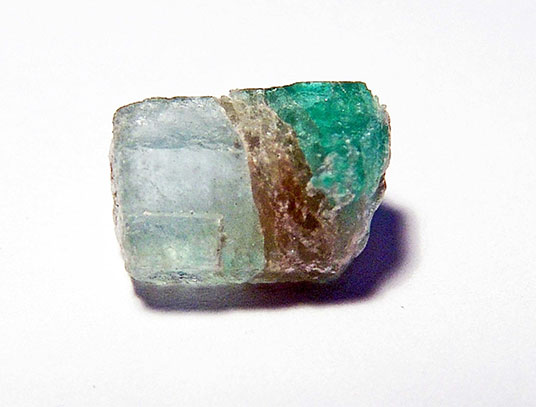 |
| Figure 8a. Bi-coloured Habachtal beryl specimen, consisting of an emerald top and a milky base (due to inclusions), separated by a mica layer. Weight 4.99 ct. (Donation G. Grundmann) |
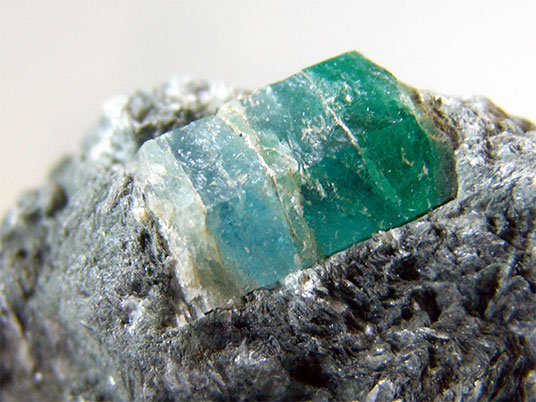 |
| Figure 8b. Bi-coloured beryl crystal on Habachtal mica schist matrix (not available for analysis). (Courtesy NHM Vienna) |
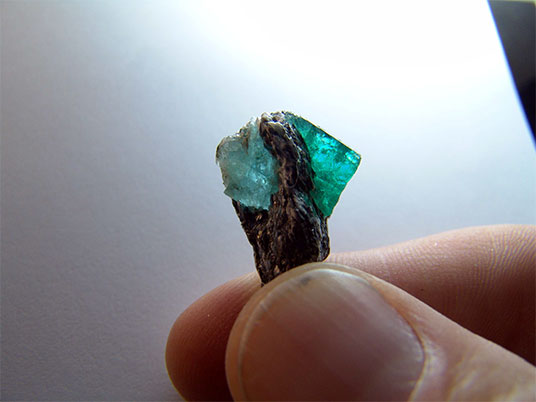 |
| Figure 8c. A blue to blue-green Habachtal crystal chip. Another, more convincing “emeraqua” chip was sold at the Munich Mineral show 2010 (both pieces not available for analysis). |
 |
| Figure 9. Corroded bi-coloured beryl crystal of 96.57 ct from Skardu Province, Pakistan (see Appendix for aerial view). Total length circa 60 mm. (Photo: K. Scarratt) |
- No other emerald occurrence currently is known to produce the requested bi-coloured beryl material.
Absorption characteristics
For comparison, see the lower right spectra of a Colombian emerald (Cr>V) and a Brazilian aquamarine; a Colombian emerald (V>Cr) (Bosshart, Fig.3, 1991) and a pure V beryl (Wood & Nassau, Fig. 5, 1968). Cr,V absorption is present in the green part of the Habachtal sample (Fig. 8a) and, to a lesser extent, in the Binntal specimen (Fig. 4, 7). The spectra of the green Habachtal top and the green Binntal crystal base are underlaid by a moderate amount of iron. In its green part, the Skardu beryl (Fig. 9) exhibits a strong Cr(Fe) spectrum.
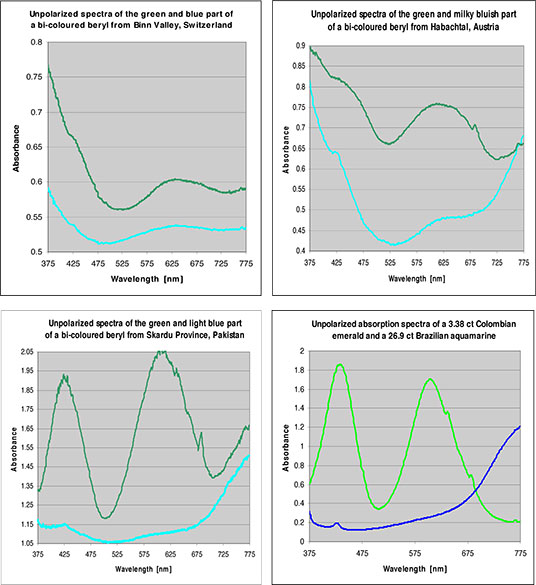 |
The light blue part of the Habachtal sample shows a vanadium band (Table 1) located at approximately 620 nm and is accompanied by the steep V3+ absorption edge and the 432 nm band in the blue region. The blue top of the Binntal beryl differs from the others and requires further analysis (LA-ICP-MS). The Skardu sample base strongly reminds an aquamarine spectrum. It approximates the emerald-aquamarine beryl type sought-after. However, the aqua part is not overly saturated blue.
Chromophore contents
In the course of analytical work, the very delicate Binntal specimen regrettably broke into tiny pieces. Although separately saved as blue and green mineral fragments, they provided chemical data which were not trustworthy. The green lot, for instance, did not show a trace of Cr or V. This is incompatible with the former Binntal emerald analyses (Krzemnicki and Bosshart, 2003) and with the absorption spectrum above.
 |
| Table 1. The chromphore element contents in two bi-coloured beryls. |
Both the Habachtal and Skardu specimens contain Cr in their green parts, the first one even a small amount of vanadium. However, Cr and Fe values found were low in the Skardu crystal, data which do not explain its saturated green colour at the crystal top and the respective, pronounced Cr absorption spectrum. The reason for these deficiencies was that the corroded crystal did not permit proper positioning on the XRF carrousel. This resulted in questionable chromophore contents. The blue part of the Habachtal specimen was lower in Fe than the green part and contained substantial vanadium. EDXRF analyses were rerun twice.
Conclusions
Bi-coloured blue to green beryls occur in two varieties : (1) as intergrowths, representing two distinct growth phases which differed in chemical nutrients and other growth parameters (they may be separated by a demarcation plane (Fig. 4) or a mineral layer other than beryl (Fig. 8a)) or (2) as beryl single crystals grading from a blue to a green zone (like in Fig. 9: the green crystal top clearly consisting of emerald and the light blue zone apparently of aquamarine). The very small number of specimens submitted and the sets of insecure chemical data for the Skardu and Binntal samples do not justify further assignments. The investigation can be resumed if more and better suited sample material should become available.
From the present observations, it is concluded that perfectly coloured Cr,V-green and true aquamarine-blue single crystals, which are zoned or which grade from emerald to aquamarine or vice versa, appear to occur, however rarely at best. This is a consequence of the two beryl varieties normally growing in markedly different geochemical environments. Nevertheless, given two growth phases providing the conditions for emerald and aquamarine crystallisation, the “emeraqua” miracle is definitely conceivable. They simply need to be detected.
Key words
bi-coloured beryl, beryl chromophores, Vis-absorption spectrum
Acknowledgements
Thanks are due to Dr. T. Mumenthaler, Zurich, for donating a number of Binntal specimens including the bi-coloured crystal pictured in Fig. 4 and to Dr. E. Gerber, Natural History Museum, University of Fribourg, Switzerland (with the assistance of A. Frey, Estavayer-le-Lac), for the loan of two Binntal beryl-on-quartz specimens. Dr. Günter Grundmann, Technical University of Munich, Germany, generously donated his Habachtal specimen (Fig. 8a) to the author. K. Scarratt, GIA, Bangkok, Thailand, loaned his bi-coloured Pakistani crystal (Fig. 9). Ken Scarratt also supplied the aerial view of the Skardu region. Dr. V. Hammer, Natural History Museum, Vienna, and A. Steiner, Bramberg, Austria, provided several Habachtal rock specimens, crystals and chips for photography. Dr. S. Karampelas, GGL, Lucerne, kindly determined the EDXRF data.
References
Bosshart G. (1991): Emeralds from Colombia. J.Gemm. 22 (7), 409–425, Fig. 3.
Google (2011): Aerial view of the Skardu region, imagery dates 8 Sep 2004 and 7 Oct 2006.
Grundmann G. (1983): Die Genese der regional-metamorphen, metasomatisch-horizontgebundenen Beryll-Mineralisationen des Habachtales, Land Salzburg, Österreich. Thesis, Technical University of Berlin, sample BE 154, pp. 142–143, 151.
Krzemnicki M.S., Bosshart G. (2003): Der Binntal-Smaragd als Juwel. Schweizer Strahler, 13 (4), 31– 33. L’émeraude du Binntal en tant que bijou. Cristallier Suisse, 13 (4), 12–14. ISSN 0370-9213.
Mumenthaler T., Frey A. (2003): L’émeraude de la vallée de Binn. Cristallier Suisse, 13 (4), 4–11. Smaragd aus dem Binntal. Schweizer Strahler, 13 (4), 24–30.
Parker R.L. (1973): Die Mineralfunde der Schweiz (The mineral finds of Switzerland). Wepf & Co, Basel. Re-edited by Stalder H.A., de Quervain F., Niggli E., Graeser St. ISBN 3-85977-002-0.
Sinkankas J. (1981): Emerald and other beryls. Chilton Book Co., Radnor, Pennsylvania. ISBN 0- 8019-7114-4.
Stalder H.A., Embrey P., Graeser St., Nowacki W. (1978): Die Mineralien des Binntales (The minerals of the Binn Valley). Naturhistorisches Museum der Stadt Bern.
Wood D.L., Nassau K. (1968): The Characterization of beryl and emerald by visible and infrared absorption spectroscopy. Am. Min. vol. 53, 777–800.
Appendix
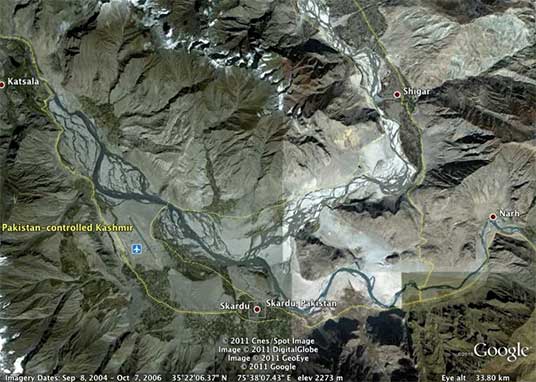 |
| Aerial view of the Skardu region. Click to enlarge. (Courtesy K. Scarratt) |